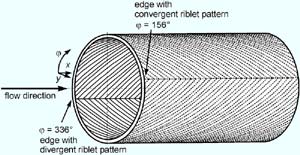
Increased bone mass in a calcitonin knockout mouse full of surprises
Bone is in a constant state of remodeling, during which osteoclasts remove old bone (resorption) and osteoblasts form new bone (formation). Calcitonin is a hormone produced by the thyroid gland and inhibits bone resorption. Following menopause, the rate of bone loss is accelerated, however women with post-menopausal osteoporosis that are treated with calcitonin (by injection or nasal spray) demonstrate increased bon

When you buy a bottle of wine for the holidays, you are actually paying for more than a bottle. That’s because during the months or years that the wine was aging, as much as 15 percent of it was lost to evaporation.
Now, that loss of good wine can be prevented — and wine prices reduced — with an atomizer system that keeps the humidity inside and outside the barrels equal, thereby eliminating the evaporation that occurs as nature works to maintain equilibrium.
The system, develop

IFDC — an International Center for Soil Fertility and Agricultural Development — has developed an innovative approach to agricultural development called Integrated Soil Fertility Management (ISFM), involving not just farmers, researchers, and extension workers but also bankers and traders, including inputs dealers and fertilizer enterprises. The holistic approach, based on the agribusiness system at the regional level, combines participatory methods to develop and extend ISFM technologies

By redesigning the shell of Ebola, Purdue University researchers have transformed the feared virus into a benevolent workhorse for gene therapy – and as one of the first gene bearers that can be inhaled rather than injected, it might prove valuable in the fight against lung disease.
While replacing the infection-causing genes inside an ordinarily harmful retrovirus with helpful genetic material is a relatively common research practice, David Sanders and his colleagues have gone a step beyond

Ebola shares a closer relationship with several bird viruses than was previously thought, bolstering the case for a common ancestor and hinting that birds might carry the deadly virus, a Purdue University research team reports.
David Sanders and his research group have discovered that the outer protein shell of Ebola has a biochemical structure similar to several retroviruses carried by birds. As scientists had known previously of genetic similarity among the viruses, this discovery makes a

A study of airflow in pipes may help solve a mystery concerning the ears of fast-swimming sharks. The results could also lead to new audio technologies, according to an engineer at Ohio State University.
Konrad Koeltzsch, a postdoctoral researcher in chemical engineering and the Alexander von Humboldt Fellow at Ohio State, and his colleagues investigated grooves in sharkskin called riblets.
Koeltzsch began to study sharkskin while he was a postdoctoral researcher at the Dresden Uni

Quantum defects have the potential to act as ultra-sensitive sensors that could offer new kinds of navigation or biological sensor technology. One type of these defect systems, nitrogen vacancy (NV)…

Breakthrough non-invasive technology for imaging through scattering media. Researchers introduce image-guided computational holographic wavefront shaping, offering fast and versatile solutions for complex imaging challenges. New study introduces a novel computational…

Modern astronomy has clung to the belief that the relativistic outflows or jets responsible for the existence of electromagnetic radiation of particularly high energies are located in the nuclei of…

In a pilot study, researchers at the University of Zurich have used artificial intelligence to detect antibiotic resistance in bacteria for the first time. This is an important first step…

New Method for Measuring Luminescence Lifetime. Researchers at the Max Planck Institute for Marine Microbiology, Leibniz-Institute for Baltic Sea Research and University of Copenhagen introduce an innovative approach to image…

UFZ study demonstrates for the first time the toxicological relevance of chemical mixtures as they occur in humans. “In our everyday lives, we are exposed to a wide variety of…

… and thermal post-treatment of flexible ultra-thin glass. Ultra-thin glass offers great potential for modern high-tech applications. Despite its superior properties compared to polymer films, the material has not yet…

Conventional catalysts for hydrogen production via water electrolysis usually contain precious metals and are expensive. However, cheaper alternatives have been developed, for example cobalt-manganese catalysts. They have a high activity…

The European Commission’s targets are ambitious: the ReFuelEU Aviation Regulation stipulates a 60 percent reduction in CO₂ emissions from aviation by 2050 compared to 1990 levels. A comprehensive EU Space…

New photonic computing method uses electromagnetic waves to solve partial differential equations rapidly. In the fields of physics, mathematics, and engineering, partial differential equations (PDEs) are essential for modeling various…

Neuroscientists show how fine motor skills of neural prostheses can be improved. Researchers at the German Primate Center – Leibniz Institute for Primate Research in Göttingen have developed a novel…

The TUM and the Pfennigparade Foundation have started a three-year research collaboration. The research will focus on the potential of robotics and AI-based technologies to help people with motor disabilities…